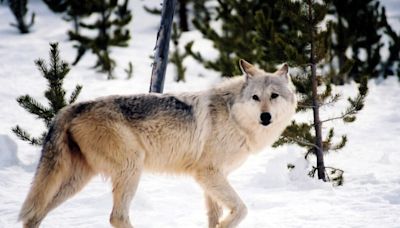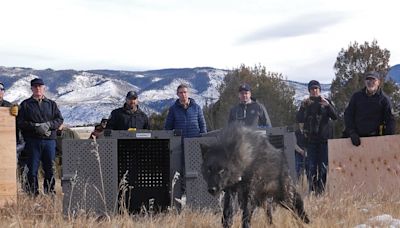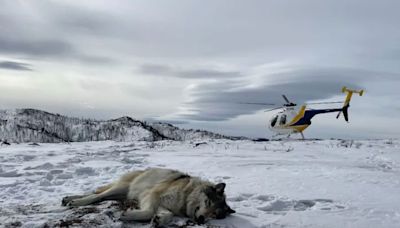Search results
Removed from Endangered Species List protections
- In January 2021, wolves were removed from Endangered Species List protections, and wolf- population management returned to individual states.
wolf.org › wolf-info › factsvsfiction
People also ask
Are gray wolves endangered?
Did Trump remove gray wolf from Endangered Species List?
Are Wolves on the Endangered Species List?
Are Wolves endangered in Wyoming?
Feb 10, 2022 · Vince Burton/Alamy. By Catrin Einhorn. Feb. 10, 2022. Gray wolves will regain federal protection across most of the lower 48 United States following a court ruling Thursday that struck down a...
Feb 12, 2022 · CNN — A federal judge reversed a Trump administration decision that removed the gray wolf from the endangered species list in the continental United States after a coalition of wildlife...
- Overview
- Under the gun
- Controversial predators
- What’s next?
A new court decision protects wolves, except in the Northern Rockies, just over a year after they were delisted. What’s next in the chaotic world of wolf conservation?
Gray wolves in most of the United States are once again protected under the Endangered Species Act, according to a new legal decision.
A U.S. District Court judge in Oakland, California, ruled on February 10 that the U.S. Fish and Wildlife Service acted improperly in delisting wolves. That decision, which went into effect in October 2020 toward the end of the Trump Administration, removed federal protections for the animals, arguing they had recovered within substantial parts of their range. This delisting decision has been upheld—and defended in court—by the Biden Administration.
The new ruling amounts to a thorough and sweeping rebuke of the wildlife agency’s policy on gray wolves, experts say. Conservationists, scientists, and even some hunters have cheered the decision, with something of an asterisk.
“It’s a good day for science, for wolves, for ecosystems, and for the people who value wolves,” says Adrian Treves, a wolf researcher and professor of environmental studies at the University of Wisconsin.
For instance, the court decision means that most forms of wolf-killing, such as hunting or trapping, will be illegal outside the Northern Rockies. This is most relevant for the Great Lakes states, including Wisconsin, which authorized a controversial wolf hunt in February 2021 that killed 218 wolves in under three days.
Gray wolves, which once roamed most of North America, were widely hunted and intentionally exterminated by government officials; by the mid-1900s, the last population of wolves in the Lower 48 was confined to Minnesota. The animals have been protected under the Endangered Species Act since the 1970s, and their populations have grown in the Great Lakes region through natural expansion and recolonization from Canada; the same is true for the Northern Rockies, though wolves were also reintroduced to central Idaho and Yellowstone National Park in the mid-1990s.
Since then, wolf management in various regions has switched back and forth between the federal government and the states, making the situation complex and confusing even for professionals in the field. In 2011, Congress introduced legislation to delist gray wolves in most of the Northern Rockies; in 2017, the Fish and Wildlife Service did the same in Wyoming. The Trump Administration did the same in a decision announced in October 2020.
Several environmental and Native American groups sued the federal government challenging the Trump Administration’s delisting rule, arguing that it failed to uphold the Endangered Species Act in several ways. And the district court responsible for addressing the lawsuits, the Northern District of California, agreed. (Learn more: Is the gray wolf still endangered? Depends whom you ask.)
“They rejected all the arguments that the [wildlife] service used to abandon the wolf issue,” says Jamie Rappaport Clark, president and CEO of Defenders of Wildlife, one of the plaintiffs in the case. “It’s a pretty significant indictment of state management of wolves.”
Mexican gray wolves (a subspecies of gray wolf) and red wolves (a separate species) were not affected by October 2020 delisting decision, and remain endangered. (These rare wolves are unique species. Here’s why that matters.)
The court rejected several justifications that the wildlife service used to delist wolves, such as the argument that gray wolves don’t represent a “species” under the definition of the Endangered Species Act because they’re found throughout many other nations and not confined to the United States. And because the animals are absent from a “significant portion of their range,” the agency’s argument that they had recovered also rang hollow, the judge said. The court also concluded that the service was wrong not to consider threats to wolves outside their core populations in the Northern Rockies and Great Lakes, explains Dan MacNulty, a wolf researcher at Utah State University.
Some influential groups in the Northern Rockies are against robust populations of wolves living in their states, for a variety of reasons. For one, ranchers worry about wolf predation on livestock, though the incidence tends to be relatively low and can be lessened with certain techniques, such as using guard dogs and protected livestock enclosures, scientists say. Hunters also argue that wolves reduce elk populations, though most of the places where wolves have been killed in Montana are at or above target levels of elk, MacNulty says.
Furthermore, the federal government and its regulations are often not popular in the rural West, and many view the wolf under that lens.
Wolf conservation has become an increasingly divisive issue, and the state legislatures of Idaho, Montana, and Wyoming have tried to seriously curtail wolves’ numbers. Since the spring of 2021, hunters and trappers in those three states (mostly Montana) have killed 24 wolves that wandered outside Yellowstone National Park, which has sparked widespread outrage among the scientific community, wolf advocates, and millions who travel to the park to get a glimpse of the animals. (Learn more: New Idaho law allows killing up to 90 percent of state’s wolves.)
Carter Niemeyer, a retired wildlife manager based in Idaho who spent much of his career in predator control, says the situation is worse than he imagined it would ever get. These states are not listening to scientists or wildlife managers, he says.
Moreover, he fears, the rise in hunting and abandonment of science-based management in the Northern Rockies could give a bad name to state management in general, making federal protections more likely to be enacted.
“I’ve been around a long time and I have never seen such an attack on wolves,” says Clark, who was also the head of the Fish and Wildlife Service from 1997 to 2001.
The Fish and Wildlife Service has begun a review of the status of wolves in the Northern Rockies, and that could theoretically lead to them being relisted too. But for some, that protection couldn’t come soon enough.
“The wolves aren’t going to wait for a status review, they’re in trouble,” Clark says.
Defenders of Wildlife and other organizations have urged the Secretary of Interior, Deb Haaland, to enact an emergency re-listing of wolves in the Northern Rockies, which is in her power—but which could come with significant political backlash.
Haaland, for her part, has signaled a strong interest in protecting wolves in an op-ed published February 7 in USA Today.
Regulatory Status Change. ESA status: endangered (February 2022) except Northern Rocky Mtn of ID, MT, WY; eastern 1/3 of OR, WA; north-central UT; threatened (Dec 2014) in MN. The gray wolf, being a keystone predator, is an integral component of the ecosystems to which it typically belongs.
Feb 15, 2022 · February 15, 2022. When gray wolves were removed from Endangered Species List 15 months ago, hunting of the species dramatically increased Raimund Linke via Getty Images. Federal...
Oct 29, 2020. Gray Wolf Final Delisting Determination Questions and Answers. The U.S. Fish and Wildlife Service finalized a rule to delist gray wolves (Canis lupis) currently listed in the contiguous United States and Mexico under the Endangered Species Act (ESA) due to recovery.






